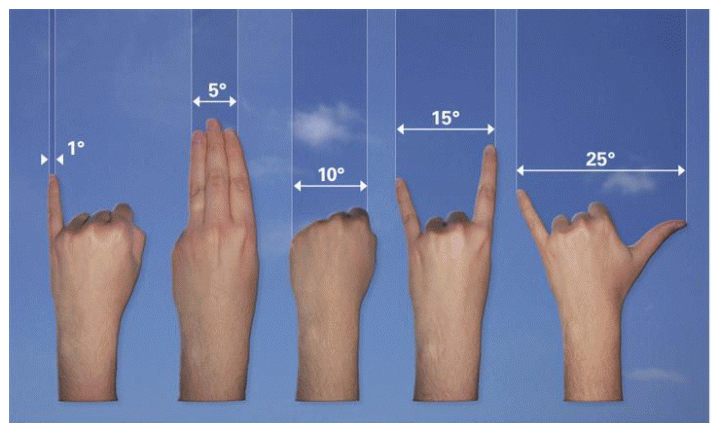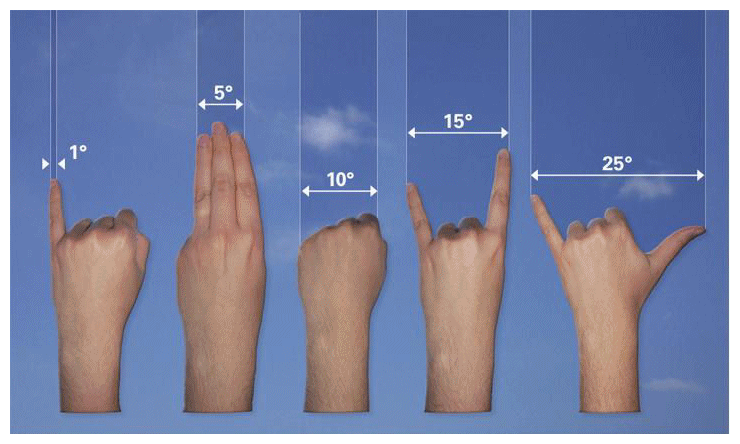This is a unit of measurement in apparent size distances between objects across the sky! This article goes over the basics regarding these units, and give you an idea how large each of these units are!
Measuring Degrees With Your Hands
Believe it or not, you can actually use your hand at arm length to get a rough estimate in measure of degrees. This is helpful for getting an idea of how far away certain objects are from each other, or how high above the horizon an object is.

When it comes to a telescope, depending on your focal length, magnification, and the eyepiece apparent field of view, this is the approximate size of your true FOV through a telescope. Obviously, when it comes to searching for objects, the lower the magnification the more sky you cover.
>20x | over 3.5°
25x | ~ 2°
50x | ~ 1.0°
100x | ~ 0.5°
200x | ~ 0.25°
Whenever this site promotes a conjunction between two celestial objects, it’s usually because they’ll be visible less than 2 degrees away from each other, and the less separation between them, the more impressive the conjunction looks!
Your Altitude and Azimuth
By default, you can use an altitude-azimuth method of knowing your way around the sky.
Remember that you can think of the sky altitude as one giant half circle, or a cosmic protractor if you will. From your vantage point, one side of the horizon to the opposite side is 180°, while your zenith directly above you is at 90°.
On the ground, with true north being your starting point, the entire horizon is a complete 360° circle.
Your Celestial Coordinates
The coordinate system is slightly different.
Your sky’s latitude is just like your terrestrial latitude (90° at the poles, 0° at the equator), except thanks to Earth’s tilt, the celestial poles and equator are in different parts of the sky depending on your ground latitude. We call it Declination.
The sky’s longitude on the other hand is more to do with Earth’s rotation, and measured in hours and minutes. We call it Right Ascension, and it is divided into 24 hourly wedges. Each wedge measures 15° across (as 360/24 = 15). As each hour is 60 minutes, every minute is ¼°, two minutes is ½°, and four minutes is equal to 1°.
As a lot of equatorial telescopes often have R.A. in increments of 10. Every 10 minutes in RA is equal to 2.5°. So again, using a wide enough eyepiece will help correct you while searching for an object when using the coordinates. You can learn more about this in Using the Celestial Coordinates, and checking out Using the Setting Circles on a German Equatorial Mount.
Now Onto Arc Minutes And Seconds
1° is 60 arc minutes (‘), and 1′ is 60 arc seconds (“).
A good rule of thumb when seeing the sky is that the Sun and Moon both measure around half a degree, or 30’ across. But that can vary depending on distance. The reason why they appear to have the same apparent size is because the Sun is about 400 times larger than our Moon, but at the same time about 400 times further away.
Sun: 31.6′ – 32.7′
Moon: 29.43′ – 33.5′
So sometimes, the Moon can appear larger or smaller than the Sun, usually around perigee and apogee respectively. The max length of totality during a total solar eclipse is not only dependent on how far into the path you are, but also how big the Moon’s apparent disc is compared to the Sun’s. Whenever this happens around apogee during a solar eclipse, the Moon is too small to cover the Sun’s disc and we get an Annular Eclipse instead.
In this prior article, you learned that a single parsec unit comes from the angle of a nearby star’s parallax shift being 1″ across.
A planet’s angular size as seen from Earth is also measured in arc-seconds. Depending on their distances from Earth, their angular sizes vary. The unaided human eye at 20/20 vision can resolve features as small as an arc minute in the sky, and the reason why all planets appear star-like to the naked eye is because their angular diameters are smaller than that!
Here are the examples
Mercury: 4.5″ – 13″
Venus: 9.7″ – 66″
Mars: 3.5″ – 25.1″
Jupiter: 29.8″ – 50.1″
Saturn: 14.5″ – 20.1″
Uranus: 3.3″ – 4.1″
Neptune: 2.2″ – 2.4″
There’s a few interesting things to take from this. Venus can go from appearing over an arc minute across to looking smaller than Jupiter and Saturn. Mars can appear larger than Saturn or slightly smaller than Uranus. This again has to do with their respective sizes, and their distances from Earth at the time!
You can determine your telescope’s resolving power by dividing 4.56 by the aperture of your telescope in inches. Or 116 by the aperture in mm. So my 8″ telescope theoretically can’t resolve features smaller than .57″ across. Therefore, Pluto can’t be resolved into a disc in most telescopes because it’s only 0.1″ across.
Even if you had a REALLY big telescope (over 45 inches in diameter), it would only happen on rare occasions, as the seeing conditions in Earth’s atmosphere usually prevent telescopes from being able to resolve objects appearing smaller than an arc second!



interesting, educative
LikeLike